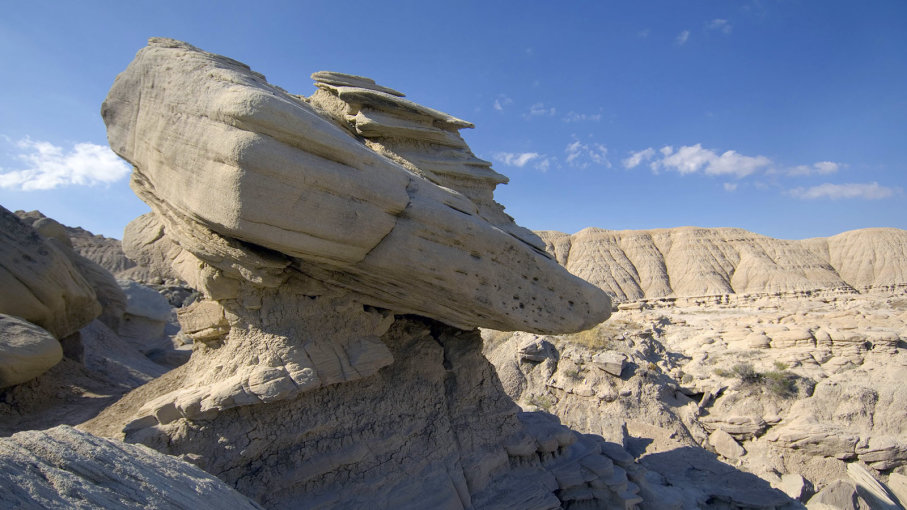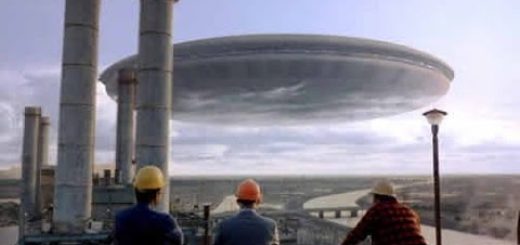Toadstools Are Mother Nature’s Geological Mushrooms

You don’t go to Toadstool Geologic Park to look at mushrooms. Strange topography is the main attraction here. Located in the Nebraska panhandle, just a quick drive from the city of Crawford, this park has been called the “moonscape” of the Badlands. There’s an otherworldly feel to the place — its plunging gullies and wind-worn rock formations seem like the perfect backdrop for a vintage sci-fi movie.
But the real show-stealers are the natural geologic columns that give the park its name. We’re talking vertical pillars capped by wide blocks of sandstone. Mushroom-like in appearance, these geologic structures are informally known as “toadstools.”
Father Time Wears You Down
Mountains shrink and canyons open up by the power of erosion and weathering. These are among the most important forces in nature, but they don’t always proceed at the same rate. Certain rocks have more resistance than others to the ravages of wind, water and precipitation. Usually, softer rocks tend to break down faster.
If there are alternating layers of hard and soft rocks piled on top of each other and they are exposed to the elements, they won’t erode or weather away in unison. Instead, the less resistant of the rock ones will disappear first and more rapidly.
That’s what’s been happening at Toadstool Geologic Park. On each toadstool, there’s a tough, sandstone lump sitting — sometimes precariously — on a pillar of softer mudstone or claystone.
“A well-cemented, indurated sandstone is resistant to erosion and protects a pedestal or spire of more easily weathered claystone or [clay-like] mudstone underneath,” Dr. R.M. Joeckel, Nebraska’s state geologist, explains in an email.
Nothing lasts forever, though. Even with their sandstone caps offering some degree of protection against the elements, the underlying columns are not immune to erosion or weathering. Bit by bit, they gradually lose material. At a certain point, they can no longer support their own capstones.
Once that happens, it’s time to shout, “timber!” Toadstool Geologic Park is littered with grounded capstones that either fell off their pillars or squashed them from above. (Mind you, the blocks can get downright huge. One stemless cap is about as big as a Volkswagen Beetle.)
Toadstool Geologic Park
Toadstools are remarkable land formations that seem to defy both Father Time and Mother Nature.
NEBRASKA TOURISM
A Fungal Garden
Obviously, the building materials didn’t just emerge out of thin air. A number of different geological formations run through this park; the youngest was deposited around 28 to 30 million years ago. Most of these began as layers of streambed sediments and volcanic ash that gradually became rock.
The toadstools appear in Orella Member of the Brule Formation sediment deposit, which Joeckel says is probably about 33 to 34 million years old. Prehistoric soil samples and fossilized roots reveal that the region was transitioning from a forested terrain to a more prairie-like environment during this period in its history.
Long after the Orella Member appeared, something changed in what’s now the northwestern Nebraska Badlands. For a long time, the rate of deposition here was outpacing the speed of erosion and weathering. In other words, new sediments (and rock layers) were being laid down faster than natural forces could break them apart or carry them off.
Yet the tables turned around 660,000 years ago. With the script flipped, flash floods, strong winds and seasonal rains started carving up formations like the Brule.
The process continues today. Layers of Orella Member sandstone that’ve been exposed to the surface are bound to have some fractures. Water, wind and chemical reactions really go to town on these cracks, making them both wider and deeper. Eventually, the fissures plunge downward into the nice, soft mudstones and claystones below.
And that’s how you get a toadstool. By the way, new ones are still emerging. Even as the mighty toadstools of yore fall apart, others are currently rising. Take a walking tour through Toadstool Geologic Park, and you’ll see the beginnings of future capstones slowly budding out of Earth.
Hoodoo Hubs
Other areas have their own versions of Nebraska’s rocky ‘shrooms. “There are features broadly like the ‘toadstools’ worldwide,” Joeckel says, “although that particular colloquial term is not in widespread use.”
Joeckel explains that wherever there’s a “comparatively resistant rock” lying on top of a weaker one (or a pile of loose sediment), features that are stool, table or “pinnacle-shaped” can appear.
In Ellsworth County, Kansas, for instance, there’s Mushroom Rock State Park, where colossal hunks of sandstone are perched on meek little pillars. In New Zealand, you can visit the pole-like “hoodoos” at Putangirua Pinnacles Scenic Preserve.
Hoodoos are actually somewhat common. “[They’re] much taller and narrower than are ‘toadstools,'” Joeckel explains, “but the role of … weathering and erosion must be similar.” The French Alps has its own collection of hoodoos, and Bryce Canyon National Park in southern Utah is jam-packed with ’em.
Scientists continue to learn new things about toadstools, hoodoos and related structures. A 2014 paper published in Nature Geoscience for example, argues that — oddly enough — the stress exerted by overlying materials might help the landmarks retain their shapes and slow down the erosion and weathering process.
Meanwhile, when it comes to the signature rocks of Toadstool Geologic Park, Joeckel thinks there’s probably some more research to be done. He admits this area of study isn’t likely to win anybody a Nobel Prize. “But,” he adds, “it’s still be enjoyable, valuable and rewarding.”



 Creators of mankind
Creators of mankind Description of “Tall white aliens”
Description of “Tall white aliens” Where they came from?
Where they came from? About hostile civilizations
About hostile civilizations The war for the Earth
The war for the Earth “Tall white aliens” about eternal life
“Tall white aliens” about eternal life Video: “Nordic aliens”
Video: “Nordic aliens” Aliens
Aliens Alien encounters
Alien encounters The aliens base
The aliens base UFO
UFO Technology UFO
Technology UFO Underground civilization
Underground civilization Ancient alien artifacts
Ancient alien artifacts Military and UFO
Military and UFO Mysteries and hypotheses
Mysteries and hypotheses Scientific facts
Scientific facts


















